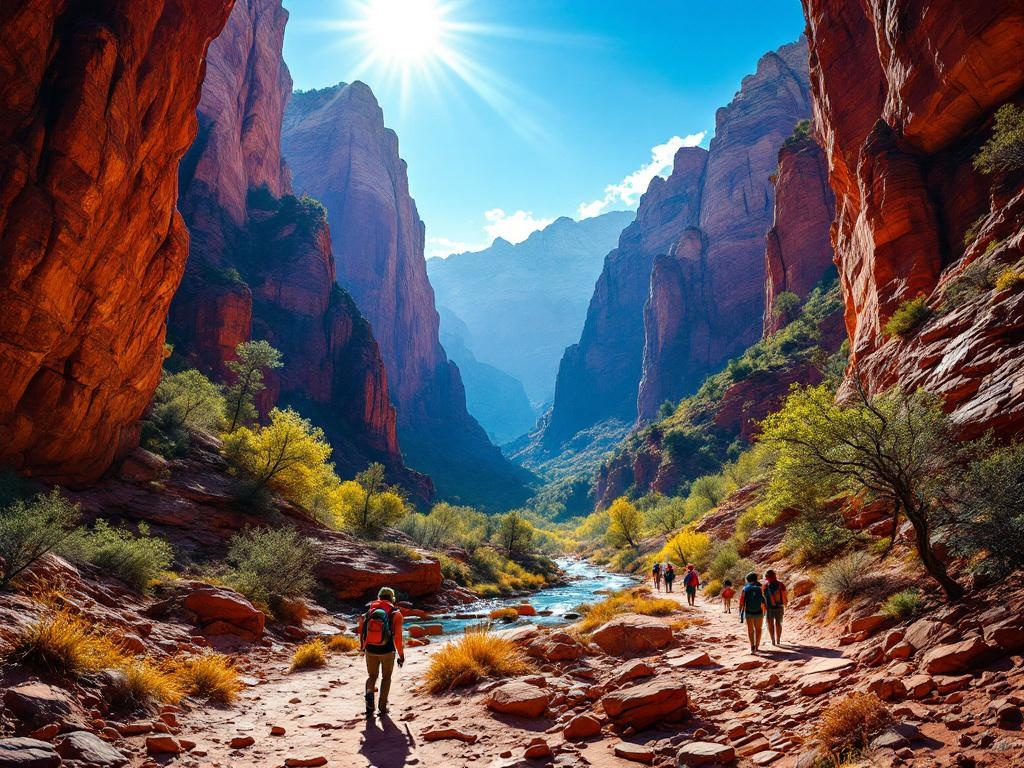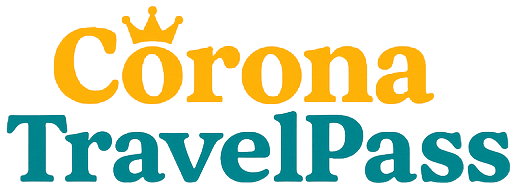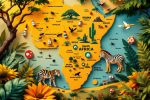Exploring Zion National Park in the USA
Discover the breathtaking beauty of Zion National Park! Explore towering sandstone cliffs, hike through narrow slot canyons like The Narrows, and witness the vibrant colors of Zion Canyon. Plan your adventure with essential tips on permits, shuttle services, and the best times to visit. Whether you’re an experienced hiker or seeking a family-friendly trail, Zion offers an unforgettable experience. Start planning your trip today!
Important information

- Zion National Park, in southwest Utah, is accessible by State Route 9 and open year-round. A free shuttle operates during peak seasons.
- Permits are required for certain hikes, including Angels Landing and The Narrows. Check the park’s website for details and to reserve.
- Spring and fall offer the best weather for hiking. Summers are hot, and winters can bring trail closures due to snow.
- Pack layers, sturdy hiking boots, plenty of water, and navigation tools. Essential gear includes rain gear, sun protection, and a first-aid kit.
- The park offers diverse lodging, from the Zion Lodge inside the park to nearby inns and unique ranch stays.
Introduction to Zion National Park
Zion National Park, located in southwest Utah, is easily accessible via State Route 9. Famous for its towering sandstone cliffs, the park showcases a vibrant tapestry of creams, pinks, and reds. The Zion Canyon Scenic Drive offers breathtaking vistas of the Virgin River and access to numerous trails. Hike through narrow slot canyons, explore the park’s diverse ecosystem, and discover its unique geology. Adventure awaits with activities like hiking, canyoneering, and climbing. Use our travel entry requirements checker available on Passport Free Countries. Check if you need a visa or other travel documents via Passport Free Countries: https://passportfreecountries.org.
Location and Accessibility
Zion National Park, nestled in southwest Utah, is easily accessible via State Route 9, a convenient location for travelers near major highways.
Operating Hours and Seasons
Zion National Park is open 24/7, 365 days a year. However, some trails and services may have seasonal closures or limited hours, so plan accordingly.
Visitor Center and Information
Begin your Zion National Park journey at the Visitor Center. Gather maps, explore informative exhibits, and secure backcountry permits. It’s the ideal starting point to discover the park’s many resources.
Planning Your Visit to Zion National Park
Reaching Zion National Park is easy. Drive the Zion-Mount Carmel Highway or fly into McCarran International Airport (LAS) in Las Vegas and then drive to Springdale, Utah, the town at the park’s entrance.
Getting Around
During peak seasons, a free shuttle runs through Zion Canyon, reducing traffic and limiting private vehicles. Use this shuttle to access trails and viewpoints.
Park Fees & Permits
Entrance fees apply to Zion National Park. Some trails, like Angels Landing, require permits obtained through a lottery. Check the park’s website for current fees and permit details.
Stay Hydrated and Wear Proper Footwear
Pack plenty of water and wear sturdy hiking shoes.
Be Ready for Changing Weather
Be prepared for fluctuating weather conditions.
Check for Updates
Before your hike, consult the park’s website for trail closures, safety alerts, and updates on potential hazards like rockfalls.
Respect Wildlife
Respect wildlife by maintaining a safe distance.
Directions and Transportation
Zion National Park is easily accessible by car via State Route 9. Visitors can also utilize the free shuttle service or explore the park by bicycle.
Shuttle Service
Zion National Park offers a free shuttle service to reduce traffic and provide access to popular trails and scenic vistas. This allows visitors to explore the park car-free, as personal vehicles may be restricted. Bicycles are another eco-friendly way to experience Zion’s beauty.
Fees and Permits
Planning your trip to Zion National Park requires understanding the entrance fees and necessary permits. Entrance to the park costs $35 per vehicle, providing access for seven days. This fee covers general park entry, but certain activities require additional permits. For instance, hiking Angels Landing requires a separate permit obtained through a lottery system. Overnight stays in the backcountry necessitate specific backcountry permits. If you plan on canyoneering or climbing, you’ll need to obtain wilderness permits. Advance planning is crucial for securing the necessary permits. Always check the park’s official website for the most up-to-date information on fees and permit requirements.
Safety Tips and Guidelines
For a safe hike, stay on marked trails.
Mountain weather is unpredictable, so pack accordingly.
Observe wildlife from afar, without approaching or feeding them.
Always inform someone of your hiking plans and expected return time.
Reservations are recommended, especially during peak season.
Bring ample water, food, and suitable gear, including maps and navigation tools.
Leave no trace behind, preserving our natural environment.
Travel Tips for a Memorable Adventure
For the optimal Zion experience, visit during the spring (April-May) or fall (September-October) for enjoyable weather and fewer crowds. Summer (June-August) brings heat and afternoon thunderstorms. Winter (November-March) offers snowy beauty but potential trail closures.
Pack essential items such as sturdy hiking boots, moisture-wicking clothing, rain gear, sunscreen, a hat, sunglasses, and a backpack. Backpacking trips necessitate additional gear, including a tent, sleeping bag, cooking equipment, and navigation tools like a map, compass, or GPS.
Zion’s weather can be unpredictable, so check the forecast and dress in layers.
Carry plenty of water, especially during summer.
Be mindful of flash floods during monsoon season (July-September) and stay on marked trails for safety.
Always inform someone of your hiking plans.
Zion National Park is dedicated to protecting its resources and enhancing visitor experiences. Shuttle systems minimize traffic. Some hikes require permits to manage crowds. Practice Leave No Trace principles to minimize your environmental impact and help preserve this beautiful park.
Best Times to Visit
Visit Zion National Park in the spring or fall for ideal weather. These seasons offer comfortable temperatures, perfect for hiking and sightseeing.
What to Pack: Hiking and Backpacking Gear
Pack these essentials for an unforgettable Zion National Park adventure. A map and compass are essential for navigating the sometimes challenging terrain. Sturdy hiking boots will protect your feet and provide ankle support and solid traction. Hydration is key, so carry ample water, particularly in warmer weather. Dress in layers to be ready for shifting conditions. Sunscreen, sunglasses, and a hat are essential for sun protection. Pack a first-aid kit for minor injuries. High-energy snacks will fuel your hike, especially on longer treks. Finally, a headlamp or flashlight is crucial for navigating trails in low light or unexpected delays.
Map and compass: essential for navigating challenging terrain.
Sturdy hiking boots: protect your feet and provide ankle support and traction.
Ample water: hydration is key, especially in warmer weather.
Layered clothing: be prepared for changing weather conditions.
Sun protection: sunscreen, sunglasses, and a hat are essential.
First-aid kit: essential for minor injuries.
High-energy snacks: fuel your hike, especially on longer treks.
Headlamp or flashlight: crucial for navigating trails in low light or unexpected delays.
Weather Conditions and Safety Precautions
Before your trip to Zion National Park, check the weather forecast and pack a variety of clothing. Zion Canyon experiences scorching summers, often exceeding 100°F (38°C). Winters are significantly colder, averaging 30-40°F (-1 to 4°C), with occasional snowfall impacting trails. Spring and fall offer the most pleasant hiking weather. Be mindful of flash floods, particularly during monsoon season (July-September). Stay informed about weather updates and be ready for sudden changes. For a safe and enjoyable visit, dress in layers, bring plenty of water, and understand potential hazards like heatstroke, hypothermia, and flash floods.
Summer
Temperatures frequently exceed 100°F (38°C).
Winter
Temperatures average between 30-40°F (-1 to 4°C) with occasional snowfall.
Spring and Fall
Ideal hiking temperatures and pleasant weather.
Monsoon Season (July-September)
Risk of flash floods.
Check the weather forecast before your trip.
Pack a variety of clothing for varying temperatures.
Stay updated on weather forecasts and be prepared for rapid changes.
Dress in layers, carry ample water, and understand potential hazards.
Visitor Use Management and Conservation Efforts
Visiting Zion National Park requires adherence to Leave No Trace principles to protect its fragile ecosystem. Observe the following guidelines: pack out all trash, stay on marked trails, and respect the park’s plants and animals. Water conservation is essential. The park’s shuttle system reduces traffic and pollution. Most trails are easily accessible, but some, like Angels Landing, require a timed entry permit to control crowds and preserve Zion’s natural beauty. These measures help maintain the park’s unique environment for future generations.
Lodging and Accommodation Options
Zion National Park offers various accommodation options to suit different budgets and travel styles. Inside the park, Zion Lodge provides convenient access to trails and amenities. Just outside the park entrance, the Desert Pearl Inn offers comfortable rooms and stunning views. For a unique experience, consider a ranch stay at Zion Ponderosa Ranch or Zion Mountain Ranch, where you can enjoy activities like horseback riding and ATV tours alongside the distinct charm of ranch-style lodging.
Inside the park
Zion Lodge: convenient trail access and close proximity to amenities.
Outside the park
Desert Pearl Inn: comfortable rooms and breathtaking vistas.
Zion Ponderosa Ranch/ Zion Mountain Ranch: unique ranch stays with activities like horseback riding and ATV tours.
Inside the Park: Zion Lodge
Staying at Zion Lodge offers unparalleled convenience for exploring Zion National Park. Its prime location puts you right in the midst of the park’s stunning trails and scenery.
Nearby: Desert Pearl Inn
The Desert Pearl Inn offers comfortable lodging near Zion National Park, making it a favorite for visitors eager to explore the park’s many attractions.
Ranches: Zion Ponderosa Ranch and Zion Mountain Ranch
Experience a unique getaway at the stunning Zion Ponderosa Ranch Resort. Choose your ideal accommodation from cozy cabins, spacious vacation homes, or authentic Conestoga wagons for an unforgettable stay. For a more traditional cabin experience, consider the nearby Zion Mountain Ranch. Both locations offer exciting activities such as horseback riding through scenic trails and ATV adventures across the rugged landscape.
Zion Ponderosa Ranch Resort
- Cozy cabins,
- Spacious vacation homes,
- Authentic Conestoga wagons.
Zion Mountain Ranch
Traditional cabin experience.
Activities at both locations:
- Horseback riding through picturesque trails,
- ATV adventures across rugged terrain.
Exploring the Natural Wonders of Zion
Zion National Park is renowned for its breathtaking sandstone cliffs and canyons, a testament to its unique geology and diverse ecosystems. Imagine vibrant hanging gardens and cascading waterfalls nourished by the Virgin River, which carved the main canyon and created a rich habitat teeming with plants and animals. The Zion Canyon Scenic Drive offers stunning vistas of the park’s landmarks. The accessible Pa’rus Trail meanders along the Virgin River, welcoming everyone from wheelchairs to bicycles. Explore Zion’s many wonders and discover its hidden gems.
Iconic Sandstone Cliffs and Canyons
Zion National Park is renowned for its breathtaking sandstone cliffs, which carve out magnificent canyons like the Narrows. This dramatic geology shapes the park’s unique ecosystems, making it a true natural wonder.
Unique Geological Features and Ecosystems
Zion National Park is renowned for its unique geological features, particularly The Narrows, a striking slot canyon. From the Virgin River’s riparian banks to the high desert plateaus, the park’s diverse ecosystems support a rich array of plant and animal life. Notable formations like Observation Point and Weeping Rock further showcase Zion’s distinct beauty.
Flora and Fauna: Wildlife in Zion
Zion National Park pulsates with a diverse range of wildlife. Mammals such as mule deer, bighorn sheep, coyotes, and foxes roam freely. Bird enthusiasts can spot peregrine falcons and California condors soaring high above, while the park echoes with the songs of numerous other birds. Lizards bask in the sun, and frogs thrive near water sources, showcasing Zion’s rich reptile and amphibian life. This vibrant ecosystem supports a remarkable abundance of life.
Adventurous Activities in Zion National Park
Embark on an unforgettable journey through Zion National Park. Discover breathtaking trails, ranging from leisurely walks to invigorating climbs. Explore the park’s famed narrow canyons with a canyoneering adventure. Seasoned thrill-seekers can tackle challenging climbs, ensuring they have the necessary equipment and expertise. For a truly immersive experience, consider backpacking or camping amidst Zion’s stunning wilderness (permits may be required).
Choose your adventure. From leisurely strolls to adrenaline-pumping climbs, Zion caters to all fitness levels. Explore trails suited to your preference and experience.
Experience canyoneering. Descend into Zion’s famed narrow canyons for a unique perspective of the park’s beauty. Specialized tours are available for safe exploration.
Challenge yourself with advanced climbs. Tackle the park’s most challenging climbs with proper equipment, preparation, and expertise. Ensure your safety by taking all necessary precautions.
Embrace the wilderness. Camp or backpack amidst Zion’s stunning scenery for an unforgettable experience. Secure necessary permits in advance to enjoy your stay.
Hiking Trails and Permits
Zion National Park offers a variety of hiking experiences, from easy strolls to challenging climbs. Permits are necessary for popular trails such as Angels Landing and The Narrows to protect the park’s ecosystem. Check the park’s website for permit details and availability before your trip to guarantee a seamless and unforgettable Zion experience.
Canyoneering and Slot Canyons
Canyoneering in Zion National Park is a thrilling adventure that involves exploring narrow slot canyons carved by water. This unique activity offers exciting challenges, but the rewards are immense for adventure seekers. Technical skills and proper equipment are essential for a safe and successful canyoneering experience. Here’s what you need to know:
Understand the Challenges. Canyoneering often involves navigating through tight spaces, rappelling down waterfalls, and swimming through pools of water. Be prepared for physical exertion and technical challenges.
Acquire Necessary Skills. Prior experience in rock climbing, rappelling, and swimming is highly recommended. Consider taking a canyoneering course to learn essential techniques and safety procedures.
Gather the Right Equipment. Invest in high-quality canyoneering gear, including a helmet, harness, ropes, carabiners, and a wetsuit or drysuit depending on the conditions.
Obtain Permits. Permits are often required for canyoneering in Zion National Park. Check the park’s website for permit information and regulations.
Check Weather Conditions. Flash floods are a serious danger in slot canyons. Check the weather forecast before you go and avoid canyoneering during periods of rain.
Climbing and Technical Skills
Zion National Park’s sandstone cliffs offer challenging climbs, requiring technical expertise. Many routes involve crack climbing, demanding specialized gear and techniques. Essential skills include anchor building, rappelling, and self-rescue. Prior sandstone experience is highly recommended. Consult park services for current regulations and route information, as closures or permits may apply.
Understand the challenge. Zion’s sandstone cliffs present a formidable challenge, demanding technical climbing expertise.
Be prepared for crack climbing. Many routes involve crack climbing, necessitating specialized equipment and techniques.
Master essential skills. Anchor building, rappelling, and self-rescue are crucial for safe climbing in Zion.
Gain experience. Prior sandstone experience is strongly advised.
Consult park services. Check with park services for current regulations and route information, as closures or permits may be in effect.
Backpacking and Camping
Plan your backpacking adventure in Zion National Park. Reserve your campsite ahead of time, particularly during popular travel periods. Pack essential gear, including a tent, sleeping bag, and cooking equipment. Remember to bring plenty of water to stay hydrated. Check the park’s website for permits and regulations before your trip.
Top Hiking Trails in Zion National Park
Angels Landing is a challenging 5.4-mile hike known for its steep switchbacks and chain sections. While strenuous, the breathtaking views of Zion Canyon make the climb worthwhile.
For a unique perspective of Zion’s beauty, hike The Narrows, a slot canyon carved by the Virgin River. This involves wading through water, sometimes up to 16 miles roundtrip.
For panoramic views, consider the strenuous 8-mile Observation Point hike. As the highest point in Zion Canyon (accessible via the East Mesa Trail), it offers a vista of the entire canyon.
The moderate 3.3-mile Watchman Trail loop offers iconic views of the Virgin River, Pa’rus Trail, and Watchman peak from a rewarding overlook.
For a short and easy option, try the 1-mile Canyon Overlook Trail, accessible from the Zion-Mount Carmel Highway. It boasts stunning views of Zion Canyon.
Angels Landing
The challenging 5.4-mile Angels Landing hike culminates atop a distinctive fin-shaped rock formation, 1,488 feet above the trailhead. While strenuous, the breathtaking views from the summit make the effort worthwhile. A permit is required for this thrilling adventure. The final ascent is particularly memorable, as hikers are aided by chains bolted into the rock, providing crucial support for a safer climb.
The Narrows
Experience the thrill of hiking The Narrows, wading through the Virgin River’s waist-deep waters, surrounded by towering canyon walls. It’s truly an unforgettable experience.
Observation Point
Zion National Park’s Observation Point rewards hikers with an unforgettable panorama of Zion Canyon. The breathtaking vista makes it a must-see destination.
Watchman Trail
Experience the beauty of Zion National Park on the Watchman Trail, a moderately challenging 3.3-mile loop near Springdale, Utah. This hike takes approximately 2-3 hours and rewards you with stunning views. You will see the Virgin River below, the Pa’rus Trail winding through the canyon, and the iconic Watchman peak itself. While the trail climbs 367 feet, the breathtaking scenery makes the effort worthwhile. Conveniently accessed from the Zion Canyon Scenic Drive, the Watchman Trail offers a rewarding experience for hikers of moderate ability.
Canyon Overlook Trail
The easily accessible Canyon Overlook Trail is a short, paved hike ideal for visitors of all skill levels, rewarding them with breathtaking views of Zion Canyon.
Special Experiences at Zion National Park
Zion National Park, designated as an International Dark Sky Place, offers incredibly dark night skies, a testament to the park’s dedication to preservation. Visitors can enjoy breathtaking views of the Milky Way and countless stars, often enhanced by ranger-led stargazing programs that explore the wonders of the universe.
Ranger-Led Programs
Enrich your visit with ranger-led tours and activities that provide insights into Zion’s history, geology, and ecology. These programs may include hikes, nature walks, and educational talks.
Seasonal Events
Throughout the year, Zion National Park hosts seasonal events, including guided hikes, photography workshops, and educational programs.
Check the park’s website for schedules and availability of ranger programs and events. Zion’s weather varies from hot, dry summers to cold, snowy winters. Consult the park’s website for current conditions before your trip.
Stargazing in a Dark Sky Certified Park
Zion National Park, a certified International Dark Sky Place, offers incredible stargazing opportunities. Its minimal light pollution creates a perfect environment for observing the celestial wonders, making for a truly exceptional experience.
Guided Tours and Ranger-led Activities
Explore Zion National Park with guided tours and ranger programs. Discover the park’s unique ecosystem and captivating history while capturing breathtaking photos. Enrich your visit with ranger-led activities and camp under the stars.
Seasonal Events and Weather Considerations
Planning a trip to Zion National Park? Ranger-led programs change with the seasons. Be prepared for summer’s heat, especially at lower elevations, by bringing plenty of water. While winter snow and ice may close some trails, it offers a serene, less crowded experience. No matter when you travel, book your accommodations early, particularly during peak season. Remember to pack essentials like sturdy hiking boots, maps, food, and water. Come prepared to discover Zion’s breathtaking scenery!
Summer
Summer’s heat, particularly at lower elevations, requires ample water.
Winter
While winter snow and ice may close some trails, it offers a serene, less crowded experience.
- Reserve lodging early, especially during peak season.
- Pack essentials like sturdy hiking boots.
- Bring maps, food, and water.











